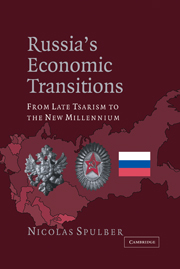Book contents
- Frontmatter
- Contents
- Figures and Tables
- Preface
- PART I THE TSARIST ECONOMIC TRANSITION
- 1 The Socioeconomic Framework
- 2 The Transition Issues
- 3 The Economic Policies
- 4 The Problems of Agriculture
- 5 The Industrial Changes
- 6 Domestic and Foreign Trade
- 7 Money and Banking
- 8 State Finance
- 9 Overall View
- PART II THE SOVIET ECONOMIC TRANSITION
- PART III THE POST-SOVIET ECONOMIC TRANSITION
- Index
1 - The Socioeconomic Framework
Published online by Cambridge University Press: 03 December 2009
- Frontmatter
- Contents
- Figures and Tables
- Preface
- PART I THE TSARIST ECONOMIC TRANSITION
- 1 The Socioeconomic Framework
- 2 The Transition Issues
- 3 The Economic Policies
- 4 The Problems of Agriculture
- 5 The Industrial Changes
- 6 Domestic and Foreign Trade
- 7 Money and Banking
- 8 State Finance
- 9 Overall View
- PART II THE SOVIET ECONOMIC TRANSITION
- PART III THE POST-SOVIET ECONOMIC TRANSITION
- Index
Summary
Territory and Population
The humiliating defeat of the Russian Empire in the Crimean War (1853–6) by an Anglo-French expeditionary force of only seventy thousand men assisting Turkey, the “sick man of Europe,” revealed clearly the Russian incompetence at the highest political and military levels, the inferiority of the quality of Russia's armaments, the absence of an adequate system of transportation for moving troops on her own territory, and Russia's overall backwardness. The military and diplomatic disaster shattered the stability of the Empire, threw Russia out of the Near East, destroyed its influence in Europe, and raised immediately the question of the future course of Russia's development.
Facing the necessary reorganization of its military establishment – increasing the combat effectiveness of its army and moving toward the modernization of its economy (and the underlying railroad network) – Russia needed, on the one hand, to ward off the widespread dissatisfaction and social instability of the peasantry concerning its postwar status, and, on the other hand, to overcome the deep-seated conflicts within the nobility concerning the increasingly evident necessity of handling as soon as possible the questions of land tenure and peasant serfdom. Finally, on February 19, 1861, Tsar Alexander II launched a historically decisive reform emancipating the peasantry from feudal dependence and also establishing a complex set of procedures intended to preserve as much of the gentry's control over most of the best land, as well as its privileged status in the society, as possible.
- Type
- Chapter
- Information
- Russia's Economic TransitionsFrom Late Tsarism to the New Millennium, pp. 3 - 29Publisher: Cambridge University PressPrint publication year: 2003



